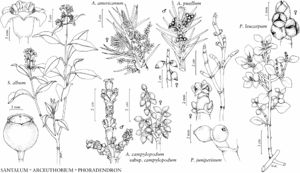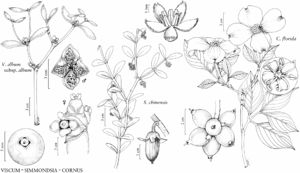Herbs, subshrubs, or shrubs, perennial, aerially parasitic on branches of angiosperms and gymnosperms, evergreen, dioecious or monoecious; roots present as haustorial endophytes. Stems erect or pendulous, brittle, nodes articulated. Leaves opposite [whorled], simple; stipules absent; petiole present or absent; blade brittle, fleshy, or scalelike, margins entire; venation pinnate or parallel [palmate]. Inflorescences unisexual or bisexual, axillary or terminal, spikelike thyrses or cymes [fascicles]. Flowers unisexual, radially symmetric or ± asymmetric; perianth epigynous; hypanthium absent (staminate flowers) or completely adnate to ovary (pistillate flowers); sepals 0; petals (2–)3–4(–6), usually distinct, sometimes connate basally, valvate, post-staminal hairs absent; nectary present or absent (staminate flowers), absent or not well defined (pistillate flowers); stamens (2–)3–4(–6), opposite petals, distinct, adnate to petals; anthers dehiscing by transverse slits or pores; pistil 1, 2[–3]-carpellate, ovary inferior, 0–1-locular, embryo sacs arising from placental nucellar complex; no true integumented ovules formed; style 0 or 1, very short; stigma 1, undifferentiated or 2[–3]-lobed [capitate]. Fruits berries, explosively dehiscent in Arceuthobium. Seeds 1 per fruit, viscin sticky or mucilaginous.
Distribution
Nearly worldwide.
Discussion
Genera 7, species ca. 575 (3 genera, 15 species in the flora).
To people in the northern hemisphere, the word mistletoe most often calls to mind a branch parasite in Viscaceae. In Europe, the Christmas mistletoe is typically Viscum album; whereas in North America, it is more often a species of Phoradendron. Mistletoe is associated historically with ancient Teutonic myths and Druidic rituals, but vestiges of these associations survive today as Yuletide kissing, a custom that dates to sixteenth-century England. Viscaceae represent just one of five clades that contain mistletoes, the others being Misodendraceae J. Agardh, Loranthaceae Jussieu, Santalaceae, and Amphorogynaceae Nickrent & Der (R. L. Mathiasen et al. 2008; D. L. Nickrent et al. 2010). Thus, the term mistletoe describes both a habit (an aerial parasite) and a taxonomic association (a member of Santalales). Early twentieth-century works (for example, A. Engler and K. Krause 1935) often treated Viscaceae as a subfamily of Loranthaceae, and indeed this practice persists today in some floras, herbaria, and popular treatments. But molecular phylogenetic work has greatly clarified relationships among the five mistletoe clades, showing that they originated independently at different time periods (R. Vidal-Russell and Nickrent 2008; J. P. Der and Nickrent 2008). Thus, the mainly tropical family Loranthaceae, whose members often have large, bird-pollinated flowers, is only distantly related to Viscaceae with small, insect-pollinated flowers.
In North America, Arceuthobium and Phoradendron are native and Viscum was introduced purposely and is now naturalized. By far, Arceuthobium is the most economically significant viscaceous mistletoe. In 1982, timber losses caused by species of Arceuthobium for the western North America were estimated as 130 million cubic meters (D. B. Drummond 1982; F. G. Hawksworth and D. Wiens 1996). Although these losses are severe, particularly in areas managed for timber production, species of Arceuthobium also play important ecological roles in natural forest ecosystems, for example its witches’ brooms provide nesting habitat for the northern spotted owl (R. Everett et al. 1997). Native trees as well as cultivated fruit and nut trees can be negatively impacted by Phoradendron in North America, Mexico, and Central and South America, but the extent of damage has not been quantified. In addition to its use as a Christmas holiday novelty, Viscum is also being explored for a variety of medicinal uses including treatments for some forms of cancer (A. Bussing 2000).
Viscaceae have been shown by molecular phylogenetic studies to be sister to Amphorogynaceae Der & Nickrent (previously a tribe of Santalaceae), which includes root and stem parasites (J. P. Der and D. L. Nickrent 2008; Su H. J. et al. 2015). Resolution of some relationships among the genera of Viscaceae had been seen from molecular studies conducted over a decade ago, but only recently has a clear picture emerged. Viscum and Notothixos Oliver are sister to the remaining genera, which include a clade consisting of Korthalsella Tieghem and Ginalloa Korthals and another of Phoradendron/Dendrophthora and Arceuthobium. From a biogeographic perspective, Arceuthobium is interesting because it is the only mistletoe to occur naturally in both the Old and New Worlds. A hypothesis by F. G. Hawksworth and D. Wiens (1972) is that Arceuthobium evolved in Asia and, following a trans-Beringian migration, underwent a massive radiation in the New World. Chloroplast spacer sequences show, however, that the New World species are most similar to Phoradendron whereas the Old World species have accumulated numerous deletions (Nickrent and M. A. García 2009). The most parsimonious hypothesis is that both Arceuthobium and Phoradendron first evolved in the New World, possibly in the Mexican highlands, where both genera are today quite diverse, and Arceuthobium then colonized the Old World.
Selected References
None.
Lower Taxa
Illustrations
Key
| 1 | Leaves scalelike; anthers 1-locular; berries on recurved pedicels, 2-colored, explosively dehiscent; seeds sticky when fruit dehisces; endosperm globose to pyriform. | Arceuthobium |
| 1 | Leaves well developed or scalelike; anthers 2-locular or multilocular; berries sessile, 1-colored, not explosively dehiscent; seeds mucilaginous when removed from fruit; endosperm ± flattened. | > 2 |
| 2 | Inflorescences spikelike thyrses, with intercalary meristems; flowers borne in cavities or grooves; anthers 2-locular; ovary 1-locular; embryos oriented longitudinally. | Phoradendron |
| 2 | Inflorescences dichasial cymes, without intercalary meristems; flowers not borne in cavities or grooves; anthers multilocular; ovary 0-locular; embryos oriented transversely. | Viscum |

